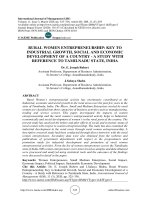Economic growth and economic development 360
Bạn đang xem bản rút gọn của tài liệu. Xem và tải ngay bản đầy đủ của tài liệu tại đây (134.17 KB, 1 trang )
Introduction to Modern Economic Growth
g (x, y) as weakly monotone, if each one is monotone in each of its arguments (for
example, nondecreasing in x and nonincreasing in y). Furthermore, let us simplify
the statement of this theorem by assuming that the optimal control yˆ (t) is everywhere a continuous function of time (though this is not necessary for any of the
results).
Theorem 7.14. (Maximum Principle for Discounted Infinite-Horizon
Problems) Suppose that problem of maximizing (7.46) subject to (7.47) and (7.48),
with f and g continuously differentiable, has a solution yˆ (t) with corresponding
path of state variable xˆ (t). Suppose moreover that limt→∞ V (t, xˆ (t)) exists (where
ˆ (ˆ
V (t, x (t)) is defined in (7.33)). Let H
x, yˆ, µ) be the current-value Hamiltonian
given by (7.50). Then the optimal control yˆ (t) and the corresponding path of the
state variable xˆ (t) satisfy the following necessary conditions:
(7.51)
ˆ y (ˆ
x (t) , yˆ (t) , µ (t)) = 0 for all t ∈ R+ ,
H
(7.52)
ˆ x (ˆ
ρµ (t) − µ˙ (t) = H
x (t) , yˆ (t) , µ (t)) for all t ∈ R+ ,
ˆ µ (ˆ
x (t) , yˆ (t) , µ (t)) for all t ∈ R+ , x (0) = x0 and lim x (t) ≥ x1 ,
(7.53) x˙ (t) = H
t→∞
and the transversality condition
ˆ (ˆ
lim exp (−ρt) H
x (t) , yˆ (t) , µ (t)) = 0.
(7.54)
t→∞
Moreover, if f and g are weakly monotone, the transversality condition can be
strengthened to:
lim [exp (−ρt) µ (t) xˆ (t)] = 0.
(7.55)
t→∞
Proof. The derivation of the necessary conditions (7.51)-(7.53) and the transversality condition (7.54) follows by using the definition of the current-value Hamiltonian and from Theorem 7.13. They are left for as an exercise (see Exercise 7.13).
We therefore only give the proof for the stronger transversality condition (7.55).
The weaker transversality condition (7.54) can be written as
x (t) , yˆ (t)) + lim exp (−ρt) µ (t) g (ˆ
x (t) , yˆ (t)) = 0.
lim exp (−ρt) f (ˆ
t→∞
t→∞
346









